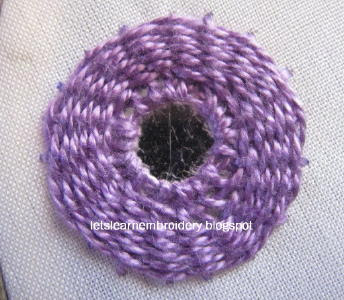Today, I’ll show you how I’m going to embroider the
peacock’s wing.
The lowest part of the wing should be dark blue
but since I don’t have that shade of blue, I’d used the same thread that I’d
used for the body.For the rest of the wing, my choice was buttonhole-knot
method.I made one straight stitch and worked buttonhole knots on it.This was
done with 3 strands of stranded cotton.
Alternate between white and black.
One row completed.
And, the remaining rows.
Whenever I admire a peacock’s beauty, I used to
wonder – “Why did God decide to create these black and white feathers?”I mean,
they’re dull looking, boring and not shiny like the rest of the feathers.I even
had to think twice before embroidering these.I guess, maybe it’s one way of God
telling us – ‘Hey, nobody’s perfect!’
To view completed project, please click here.













